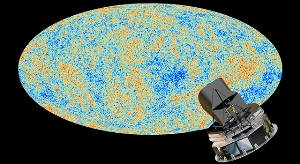Oct 25 2013
The Planck space telescope has been turned off after spending nearly 4.5 years soaking up the relic radiation from the Big Bang and studying the evolution of stars and galaxies throughout the history of the universe.
 The oldest light in the universe, called the cosmic microwave background, as observed by the Planck space telescope is shown in the oval sky map. An artist's concept of Planck is next to the map. Image credit: ESA and the Planck Collaboration - D. Ducros
The oldest light in the universe, called the cosmic microwave background, as observed by the Planck space telescope is shown in the oval sky map. An artist's concept of Planck is next to the map. Image credit: ESA and the Planck Collaboration - D. Ducros
Planck is a European Space Agency (ESA) mission with significant contributions from NASA.
Mission controllers at ESA's operations center in Darmstadt, Germany sent the final command to the Planck satellite today, marking the end of operations for what some like to call a "time machine."
"We are only part way through the analysis of the data and have already learned a huge amount about the universe from the Milky Way galaxy, to the observable edge, and beyond to the first tiny fraction of a second after the Big Bang," said U.S. Planck Project Scientist Charles Lawrence of NASA's Jet Propulsion Laboratory, Pasadena, Calif.
Launched in 2009, Planck was designed to tease out the faintest relic radiation from the Big Bang, called the cosmic microwave background. This radiation preserves a picture of the universe as it was about 380,000 years after its birth, and provides details of the initial conditions that led to the universe we live in today.
Results from the mission presented by scientists in March 2013 provided revised values for the relative proportions of the ingredients of the universe, namely normal matter that makes up stars and galaxies; dark matter, which has so far only been detected indirectly by its gravitational influence; and dark energy, a mysterious force thought to be responsible for accelerating the expansion of the universe. The NASA news release about these results is at http://www.jpl.nasa.gov/news/news.php?release=2013-109 .
JPL built critical components of Planck's science instruments, including bolometers for the mission's high-frequency instrument; a 20-Kelvin (minus-424-degree-Fahrenheit) cryocooler for both the low- and high-frequency instruments; and amplifier technology for the low-frequency instrument.
But cooling instruments to these extreme temperatures cannot be maintained forever and, indeed, the High Frequency Instrument exhausted its liquid helium coolant in January 2012, just as expected.
The Low Frequency Instrument meanwhile continued to operate at somewhat higher temperatures using the remaining two coolers, and it observed the sky until Oct. 3. After conducting post-science activities, it was manually switched off Oct. 19.
"Planck is a model for international cooperation in space. Both Europe and the U.S. contributed enabling new technologies, giving Planck unprecedented scientific capability," said Ulf Israelsson, the U.S. Planck Project Manager at JPL.
Read the full ESA news release at: http://www.esa.int/Our_Activities/Space_Science/Planck/Last_command_sent_to_ESA_s_Planck_space_telescope .
Planck is a European Space Agency mission, with significant participation from NASA. NASA's Planck Project Office is based at JPL. JPL contributed mission-enabling technology for both of Planck's science instruments. European, Canadian and U.S. Planck scientists work together to analyze the Planck data. More information is online at http://www.nasa.gov/planck, http://www.esa.int/planck and http://planck.caltech.edu .